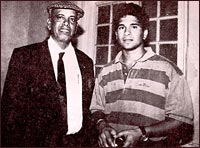 January 23, 2002
January 23, 2002
Overawed by Achrekar
- Jonathan Dyson
It must be a surreal sight. Before he joins his team-mates prior to each Test series, Sachin Tendulkar ensures, without fail, that he visits an old, now largely house-bound man in a modest apartment in the Aagar Bazhar area of Dadar, Mumbai.
The quiet street, and the shabby exterior of the flat, with dirty green walls and small windows, suggest it to be an unlikely calling port for India's wealthiest and most successful current player. Yet this apartment is home to perhaps the most significant man in Tendulkar's life -- his long-time coach and mentor Ramakant Achrekar.
He lives with his family in the flat, and now only coaches about twice a week, suffering as he is from mild paralysis.
I had the pleasure of meeting him at his home last week, and though his conversation is limited nowadays, I still felt overawed to be in the presence of such a significant figure in the history of Indian cricket.
Achrekar is a member of that rare species -- an oustanding cricket coach who never played a Test. In fact, Achrekar played just one first-class match, in 1963-4 for All-India State Bank against Hyderabad in the Moin-ud-Dowla tournament.
And it was in fact only a chance meeting that turned Achrekar to coaching. As Sandeep Bamzai explains in the recently-published 'Guts & Glory' - the Bombay Cricket Story, in the mid-1960s, part of his duties as secretary of New Hind were to organise the club's cricket gear.
One evening he went to India Sports House to purchase some equipment, and while he was there a young boy entered the shop. The shop owner told Achrekar that young Suresh Shastri was a talented cricketer, and asked him to coach him.
 Achrekar's demeanour as a coach of Shastri so impressed the president of Arya Samaj, Mithailal Singh, that Singh offered to pay Achrekar to coach his son as well. Achrekar refused to accept any more than Rs 50 per month for expenses, but he soon became coach of Dayanand Balak Vidyalaya, and it wasn't long before he was holding regular sessions at Sassanian Cricket Club on Azad Maidan.
Achrekar's demeanour as a coach of Shastri so impressed the president of Arya Samaj, Mithailal Singh, that Singh offered to pay Achrekar to coach his son as well. Achrekar refused to accept any more than Rs 50 per month for expenses, but he soon became coach of Dayanand Balak Vidyalaya, and it wasn't long before he was holding regular sessions at Sassanian Cricket Club on Azad Maidan.
It was here and at Shivaji Park that he made his name in the late 1980s through the oustanding performances of two of his pupils, Tendulkar and Vinod Kambli, who by this time were consistently destroying school boy attacks in the Giles and Harris Shields.
When I entered Achrekar's apartment, and found myself chatting with him in his front room, I almost thought for a moment that I had come across a fellow Yorkshireman, for he was wearing a tweed, peaked cap -- the typical headgear of old men where I come from -- and exhibited the same kind of warmth and simple approach to life for which Yorkshiremen are renowned.
And it soon became clear why his demeanour so impressed Mithailal Singh all those years ago. While we conversed, he always maintained strong, deliberate eye contact, and chose each of his words with great care. And despite reeling off several questions which he has probably answered hundreds of times before, he displayed plenty of enthusiasm about what I wanted to know.
I asked him how he dealt with a player of Tendulkar's exceptional ability. "More than anything else, I was keen for him to play his natural game," he replied, while eccentrically emphasising his point by miming a pleasant cover drive with his left hand. "Yet I made sure he worked hard at his game. Practise, practise, practise makes a man."
 It certainly made a man of Tendulkar. Under Achrekar's strict guidance, the young genius would practise each day between 7 and 9 am and 3.30 to 6pm. In between he would play matches. Lots of them. In fact, I had heard before meeting Achrekar that if Tendulkar fell for a low score in one match, his coach would take him to another game so he could bat again.
It certainly made a man of Tendulkar. Under Achrekar's strict guidance, the young genius would practise each day between 7 and 9 am and 3.30 to 6pm. In between he would play matches. Lots of them. In fact, I had heard before meeting Achrekar that if Tendulkar fell for a low score in one match, his coach would take him to another game so he could bat again.
"Yes, in fact in the process," Achrekar told me, "Tendulkar found that he played for about thirteen different teams. And on one day when he was fourteen, he scored a century in the Giles Shield and a double century in the Harris Shield."
Achrekar's eagerness for his pupils to play their natural game was remarkable. The most famous example came when Achrekar suggested to Tendulkar that he alter his exaggerated bottom-hand grip. However, due to Tendulkar's insistence, Achrekar eventually agreed that he keep the grip. A good decision, it seems.
Vaibhav Purandare, a Mumbai-based journalist, told me a similar story. Vaibhav was coached for a while by Achrekar, and he noticed that he did not have a particularly big back-lift. However, instead of making him lift his bat up, and thereby make him play unnaturally, he simply suggested lifting his bat from the position of fourth slip. Vaibhav found batting easier thereafter.
Achrekar's lounge, adorned as it is with framed cuttings, pictures and trophies, is testament to an outstanding coaching career. Along with Tendulkar and Kambli, he has helped produce several other Ranji Trophy players, including Padam Shastri, Suresh Shastri, Sharad Rao, Bawinder Singh Sandhu, Ravi Kulkarni, Ramnath Parkar, Lalchand Rajput, Chandu Pandit and Pravin Amre.
In 1992, the ultimate accolade came Achrekar's way -- the Dronacharya Award for the best coach in India. Ten years on, Achrekar is still proud of the achievement. Yet the clearest sign of his success as a coach surely comes in the form of his most famous pupil, every time he bats.
GE Features
©1996 to 2001 rediff.com India Limited. All Rights Reserved.